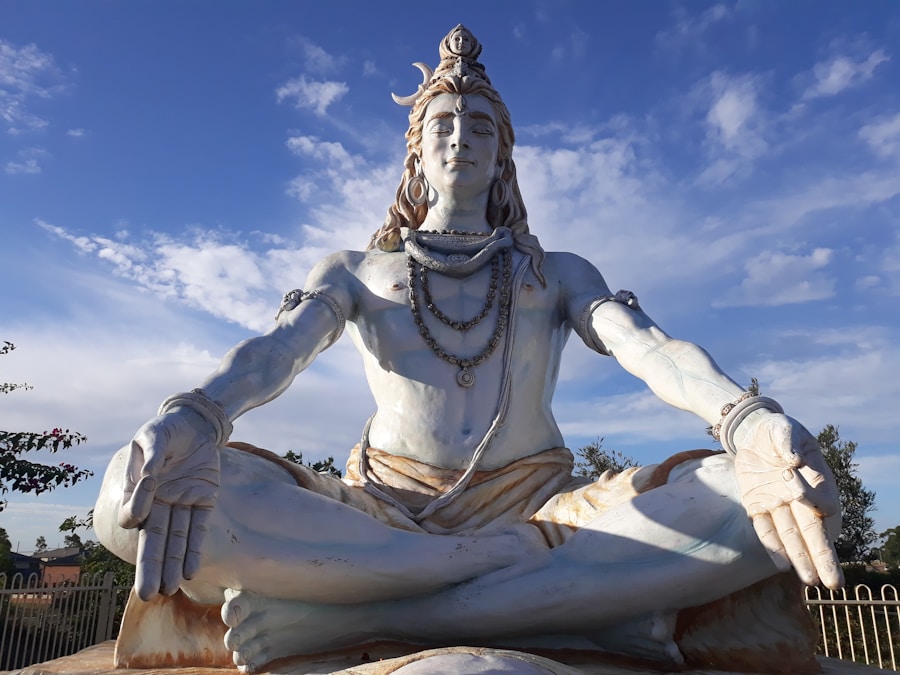The Bhagavad Gita, a 700-verse Hindu scripture that is part of the Indian epic Mahabharata, serves as a profound philosophical text that addresses the moral and spiritual dilemmas faced by individuals. Within its verses, the concept of yoga emerges as a central theme, representing a path to self-realization and spiritual enlightenment. The dialogue between Prince Arjuna and Lord Krishna unfolds on the battlefield of Kurukshetra, where Arjuna grapples with his duty as a warrior and the moral implications of engaging in battle against his own kin.
This setting provides a rich backdrop for exploring the multifaceted nature of yoga, which transcends mere physical postures and delves into the realms of ethics, devotion, and knowledge. Yoga in the Bhagavad Gita is not merely a practice but a comprehensive philosophy that encompasses various paths to achieve union with the divine. It invites practitioners to explore their inner selves and understand their relationship with the universe.
The Gita’s teachings on yoga are timeless, offering insights that resonate with individuals seeking purpose and clarity in their lives. As we delve deeper into the text, we uncover how yoga serves as a means to navigate life’s complexities, providing guidance on how to live with integrity, compassion, and wisdom.
Key Takeaways
- The Bhagavad Gita introduces the concept of yoga as a path to spiritual enlightenment and self-realization.
- Yoga in the Bhagavad Gita is defined as the discipline of action, the discipline of knowledge, and the discipline of devotion.
- The types of yoga in the Bhagavad Gita include Karma Yoga (the yoga of selfless action), Jnana Yoga (the yoga of knowledge), and Bhakti Yoga (the yoga of devotion).
- The practice of yoga in the Bhagavad Gita emphasizes the importance of selfless action, knowledge, and devotion in achieving spiritual growth and liberation.
- The philosophy of yoga in the Bhagavad Gita teaches the importance of maintaining inner peace, equanimity, and detachment from the fruits of one’s actions.
The Concept of Yoga in the Bhagavad Gita
In the Bhagavad Gita, yoga is defined as a disciplined approach to life that leads to self-realization and union with the Supreme Being. The term “yoga” itself derives from the Sanskrit root “yuj,” which means to yoke or unite. This concept of union is pivotal; it signifies the integration of the individual self (Atman) with the universal consciousness (Brahman).
The Gita emphasizes that true yoga is not confined to physical exercises but encompasses mental, emotional, and spiritual dimensions. It is about aligning one’s actions with higher principles and understanding one’s place in the cosmic order. Krishna elucidates that yoga is a means to attain equanimity amidst life’s dualities—success and failure, pleasure and pain, gain and loss.
This balanced approach is essential for achieving inner peace and clarity. The Gita teaches that through yoga, one can cultivate detachment from the fruits of actions while remaining fully engaged in one’s duties. This principle of selfless action (karma yoga) is fundamental to the Gita’s philosophy, encouraging individuals to act without attachment to outcomes, thereby fostering a sense of liberation from the cycle of birth and rebirth (samsara).
Types of Yoga in the Bhagavad Gita

The Bhagavad Gita delineates several paths of yoga, each catering to different temperaments and inclinations. Among these, Karma Yoga, Bhakti Yoga, and Jnana Yoga stand out as primary pathways toward spiritual growth. Karma Yoga, or the yoga of action, emphasizes performing one’s duty without attachment to results.
This approach not only purifies the mind but also aligns one’s actions with dharma, or righteous duty. In contrast, Bhakti Yoga focuses on devotion and love for God.
It encourages practitioners to cultivate a personal relationship with the divine through prayer, worship, and surrender. The Gita highlights that sincere devotion can lead to profound spiritual experiences and ultimately union with God. This path is particularly accessible for those who may find intellectual pursuits challenging or who seek emotional fulfillment through their connection with the divine.
Jnana Yoga, or the yoga of knowledge, involves the pursuit of wisdom and understanding through study and contemplation. It encourages individuals to question their beliefs and seek deeper truths about existence. The Gita teaches that through self-inquiry and discernment, one can transcend ignorance and realize their true nature.
Each of these paths offers unique insights and practices that cater to diverse spiritual seekers, illustrating the Gita’s inclusive approach to yoga.
The Practice of Yoga in the Bhagavad Gita
The practice of yoga as outlined in the Bhagavad Gita is deeply intertwined with daily life and ethical conduct. Krishna emphasizes that true yoga is not limited to formal meditation or rituals but is reflected in how one engages with the world. The Gita advocates for a lifestyle that embodies principles such as self-discipline, moderation, and mindfulness.
For instance, Krishna advises Arjuna to maintain balance in eating, sleeping, working, and recreation—an approach that fosters overall well-being and prepares the mind for deeper spiritual practices. Moreover, the Gita underscores the importance of cultivating virtues such as compassion, humility, and forgiveness as integral aspects of yoga practice. These qualities not only enhance personal growth but also contribute to harmonious relationships with others.
By embodying these virtues in everyday interactions, practitioners can transform their lives into a continuous practice of yoga. This holistic view encourages individuals to see every action as an opportunity for spiritual growth, reinforcing the idea that yoga is a way of life rather than a mere set of techniques.
The Philosophy of Yoga in the Bhagavad Gita
The philosophical underpinnings of yoga in the Bhagavad Gita are profound and multifaceted. At its core lies the understanding of the self (Atman) as eternal and unchanging amidst the transient nature of the physical world. The Gita teaches that realizing this distinction between the eternal self and temporary material existence is crucial for liberation (moksha).
This realization fosters a sense of detachment from worldly desires and attachments, allowing individuals to navigate life with greater clarity and purpose. Additionally, the Gita presents a vision of interconnectedness among all beings. It posits that every individual is part of a larger cosmic whole, emphasizing that actions should be performed with an awareness of their impact on others.
This interconnectedness is foundational to ethical living and social responsibility. The philosophy of yoga encourages practitioners to act with compassion and empathy, recognizing that their well-being is intrinsically linked to the well-being of others. Such insights challenge individuals to transcend egoistic tendencies and embrace a more expansive view of existence.
The Relevance of Yoga in the Bhagavad Gita Today

In contemporary society, where individuals often grapple with stress, anxiety, and existential questions, the teachings of the Bhagavad Gita on yoga remain remarkably relevant. The principles outlined in this ancient text offer practical guidance for navigating modern challenges. For instance, the emphasis on mindfulness and presence resonates deeply in today’s fast-paced world, where distractions abound.
By integrating practices such as meditation and self-reflection into daily routines, individuals can cultivate inner peace and resilience. Furthermore, as people increasingly seek meaning beyond material success, the spiritual dimensions of yoga highlighted in the Gita provide a pathway for personal fulfillment.
In an era marked by social upheaval and environmental concerns, these teachings inspire collective responsibility and ethical living. The relevance of Bhakti Yoga also shines through in today’s context as many seek connection amid feelings of isolation. The practice of devotion—whether through prayer, community service, or artistic expression—can foster a sense of belonging and purpose.
Ultimately, the Bhagavad Gita’s teachings on yoga offer timeless wisdom that empowers individuals to lead lives rooted in authenticity, compassion, and spiritual awareness amidst an ever-changing world.
In the Bhagavad Gita: Ancient Wisdom, the concept of karma plays a significant role in guiding individuals towards righteous actions and spiritual growth. For a deeper understanding of the Law of Karma and the different types of karma – akarma, vikarma, and freedom of choice – readers can explore the related article Introduction to the Basic Concepts of the Gita: Law of Karma, Concept of Karma, Akarma, Vikarma, and Freedom and Choice. This article delves into the fundamental principles that govern the consequences of our actions and the importance of making conscious choices in alignment with our dharma.
FAQs
What is the Bhagavad Gita?
The Bhagavad Gita is a 700-verse Hindu scripture that is part of the Indian epic Mahabharata. It is a sacred text of the Hindu religion and is considered one of the most important spiritual classics in the world.
What is yoga according to the Bhagavad Gita?
In the Bhagavad Gita, yoga is described as the path to spiritual realization and self-discovery. It is a means to attain inner peace, self-mastery, and union with the divine.
What are the different types of yoga mentioned in the Bhagavad Gita?
The Bhagavad Gita mentions several types of yoga, including Karma Yoga (the yoga of selfless action), Bhakti Yoga (the yoga of devotion), and Jnana Yoga (the yoga of knowledge and wisdom).
What are some key teachings about yoga in the Bhagavad Gita?
The Bhagavad Gita teaches that yoga is a path to self-realization and spiritual growth. It emphasizes the importance of selfless action, devotion to the divine, and the pursuit of knowledge and wisdom.
How has the Bhagavad Gita influenced the practice of yoga?
The Bhagavad Gita has had a significant impact on the practice of yoga, as it provides philosophical and spiritual guidance for practitioners. Many modern yoga teachers and practitioners draw inspiration from the teachings of the Bhagavad Gita in their practice.






















+ There are no comments
Add yours